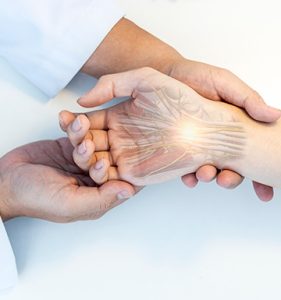Giving You a Hand with Carpal Tunnel Syndrome
Have you ever experienced tingling or numbness in your fingers and wrote it off as just “pins or needles?” It if happens often, you may want to take notice as it could actually be Carpal tunnel syndrome (CTS), a syndrome that affects 1-5% of the population and can seriously impact your daily life if left untreated. Carpal Tunnel Syndrome occurs when the median nerve, running from the forearm into the palm, gets compressed at the wrist. This compression happens as the nerve passes through the carpal tunnel—a narrow passage formed by wrist bones and the transverse carpal ligament. Repetitive movements, such as those involved in frequent cell phone use, and activities requiring prolonged wrist bending can exacerbate CTS.
Early Symptoms to Watch For
- Tingling or Numbness: A common early sign is tingling or numbness in the thumb, index, and middle fingers, often felt as if your hand is “falling asleep,” especially at night.
- Hand Weakness: Difficulty with grip strength or holding objects can indicate CTS. Tasks like holding a cup or steering wheel might become challenging.
- Pain or Discomfort: Wrist or hand pain, particularly at night, can extend up the arm and interfere with sleep and daily activities.
- Other Symptoms: Pain or tingling traveling up the forearm, weakness affecting fine motor skills, and involuntarily dropping items are also signs of CTS.
Symptoms usually start gradually and worsen over time. If untreated, persistent pressure on the median nerve can lead to severe symptoms and nerve damage.
Why Prompt Diagnosis Matters
Addressing CTS early with lifestyle changes, wrist splints, and targeted exercises can effectively relieve pressure on the median nerve and alleviate symptoms. Early intervention is essential to prevent the condition from worsening and to avoid more invasive treatments. Without treatment, CTS can lead to permanent nerve damage and loss of hand function. Early diagnosis not only enhances the chances of successful outcomes but also minimizes the risk of long-term complications and the need for surgery.
Treatment Options
Early cases can often be managed without surgery through bracing or splinting, anti-inflammatory drugs, activity modification, steroid injections and physical therapy. If nonsurgical treatments fail, carpal tunnel release surgery may be necessary. The procedure involves dividing the transverse carpal ligament to alleviate pressure on the nerve, with a rare chance of recurrence.
Take Action
Don’t ignore the signs of carpal tunnel syndrome. If you experience persistent tingling, numbness, or weakness in your hand, you should consult with your physician. Diagnosis may involve a physical exam, wrist tests, nerve condition studies, or imaging to evaluate nerve compression.
Early diagnosis and treatment can prevent pain and permanent damage. Call us today or visit our website to learn more about this condition and how we can help you get back to an active, pain-free life. Your hands will thank you!



